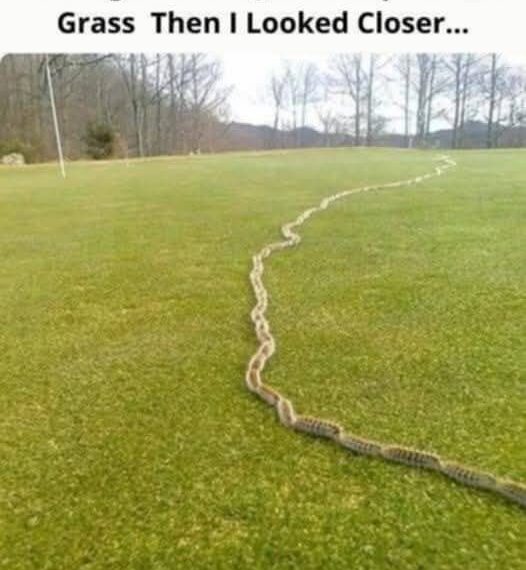🌿 I Thought It Was a Rope. What I Found in My Backyard Left Me Speechless (and Slightly Concerned)
We all know how nature has a way of surprising us… but nothing could have prepared me for what I saw lying still on my backyard lawn. It was a bright, sunny afternoon when I stepped outside, hoping to enjoy the quiet of my garden. My eyes scanned the yard, taking in the vibrant greenery, when something caught my attention.
There, stretched out across the grass, was a long, coil-like shape. My first thought? “That’s just a piece of rope.” Maybe it had blown in from a nearby construction site or been left behind by a previous owner.
But as I stepped closer to investigate, I froze. This was no ordinary piece of rope.
🐍 What I Thought Was Rope… Was Something Else Entirely
Upon closer inspection, I realized the object was moving—just barely, but enough to confirm it wasn’t a piece of rope at all. It looked like it had a texture similar to a rope, but there were small, subtle, undulating movements, as if it were alive.
My heart skipped a beat. Could it be a snake? Or something worse?
I leaned in even closer, trying to make out more details. And that’s when it hit me: what I was looking at was a large, almost perfectly camouflaged snake. Its body was coiled, and it blended so well with the grass that I hadn’t noticed it at first.
🐍 The Hidden World of Backyard Snakes
It’s not uncommon to find snakes in your yard, especially if you live in an area that has lots of natural terrain. Snakes are often found in gardens, under rocks, or around foliage where they can find shelter, food, and water.
What I had stumbled upon was likely a garden or rat snake—harmless creatures that play an important role in controlling the pest population in the garden. However, the fact that I hadn’t noticed it until I was practically on top of it was a reminder of just how well these creatures can camouflage themselves in nature.
🔍 Why Did It Look Like a Rope?
You might be wondering why a snake in the grass would look like a piece of rope in the first place. The answer lies in the shape and color of the snake.
Many snakes, especially those that live near urban or suburban areas, have evolved to blend into their environments for protection. Their bodies often feature earthy tones and patterns that mimic the look of twigs, grass, or even rope.
In this case, the snake I found was dark with lighter, almost faded areas that resembled knots in a rope. The way it was laying flat against the grass made it look still and lifeless—just like a discarded piece of rope. This kind of camouflage is a survival tactic to avoid predators, and it works remarkably well.
🐍 How to Safely Handle Snake Sightings
Next page





